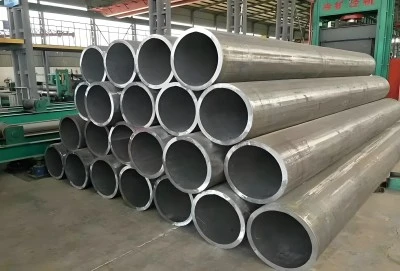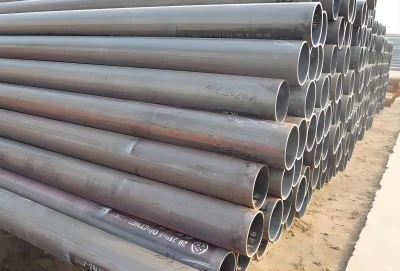When it comes to welding S235 steel pipes, understanding the optimal process parameters is crucial for achieving high-quality, durable welds. S235 steel is a popular choice in various industries due to its excellent weldability and mechanical properties. In this comprehensive guide, we'll explore the welding process parameters, techniques, and methods that yield the best results when working with S235 pipes.
|
|
|
Optimal Welding Techniques for S235 Steel Pipes
S235 steel pipes are widely used in construction, manufacturing, and infrastructure projects due to their versatility and strength. To ensure the integrity of these pipes in their applications, it's essential to employ the right welding techniques. Here are some of the most effective methods for welding S235 steel pipes:
1. Shielded Metal Arc Welding (SMAW): Also known as stick welding, SMAW is a popular choice for welding S235 pipes. This method uses a consumable electrode coated in flux to lay the weld. SMAW is particularly useful for outdoor applications and when working with thicker materials.
2. Gas Metal Arc Welding (GMAW): Commonly referred to as MIG welding, GMAW uses a continuous wire electrode and shielding gas to create the weld. This method is known for its speed and efficiency, making it ideal for the high-volume production of S235 steel pipe welds.
3. Gas Tungsten Arc Welding (GTAW): Also called TIG welding, GTAW uses a non-consumable tungsten electrode to produce the weld. This method offers precise control and is excellent for thin-walled S235 pipes or when a high-quality finish is required.
4. Submerged Arc Welding (SAW): This method is particularly effective for large-diameter S235 steel pipes. SAW uses a continuously fed electrode and a separate granular flux to protect the weld area from atmospheric contamination.
When selecting a welding technique for S235 steel pipes, consider factors such as the pipe thickness, diameter, and the specific requirements of your project. Each method has its advantages, and the choice often depends on the application and desired outcome.
Recommended Welding Temperatures and Speeds for S235 Steel
Achieving the right balance of temperature and speed is crucial for producing high-quality welds on S235 steel pipes. Here are some general guidelines to consider:
Temperature: The ideal welding temperature for S235 steel typically ranges from 1,450°C to 1,520°C (2,642°F to 2,768°F). However, it's important to note that the exact temperature can vary depending on the specific welding process and the thickness of the pipe.
Speed: Welding speed for S235 pipes can vary widely based on the welding method and pipe dimensions. As a general rule:
- For SMAW: 1.5 to 3 mm/s (3.5 to 7 in/min)
- For GMAW: 5 to 10 mm/s (12 to 24 in/min)
- For GTAW: 1 to 2 mm/s (2.5 to 5 in/min)
- For SAW: 10 to 20 mm/s (24 to 47 in/min)
These speeds are approximate and may need adjustment based on specific project requirements and pipe characteristics. It's crucial to find the right balance between temperature and speed to ensure proper fusion and minimize the risk of defects.
Preheating: For S235 steel pipes with a thickness greater than 25mm, preheating to a temperature of 100°C to 200°C (212°F to 392°F) is recommended to reduce the cooling rate and minimize the risk of cracking.
S235 Steel's Response to Different Welding Methods
S235 steel is known for its excellent weldability, but its response can vary depending on the welding method used. Understanding these differences can help you choose the most appropriate technique for your specific application:
1. SMAW (Stick Welding): S235 steel responds well to stick welding, especially for thicker pipes. The process creates a strong, durable weld but may require more cleanup due to slag formation. It's particularly suitable for outdoor applications where wind might affect gas-shielded processes.
2. GMAW (MIG Welding): This method produces clean welds on S235 steel with minimal spatter. The steel's low carbon content makes it less susceptible to heat-affected zone (HAZ) issues, allowing for faster welding speeds. GMAW is excellent for automated processes and high-volume production.
3. GTAW (TIG Welding): S235 steel's good thermal conductivity makes it suitable for TIG welding, especially for thin-walled pipes. This method allows for precise control and high-quality welds but is generally slower than other processes.
4. SAW (Submerged Arc Welding): For large-diameter S235 steel pipes, SAW provides excellent penetration and high deposition rates. The steel's composition allows for good flux-metal reactions, resulting in clean, high-quality welds.
5. Friction Stir Welding (FSW): While less common, FSW can be used on S235 pipes. This solid-state welding process reduces the risk of distortion and produces welds with excellent mechanical properties.
Regardless of the method chosen, it's crucial to consider factors such as the pipe's thickness, diameter, and the specific project requirements. Proper surface preparation, including cleaning and beveling, is essential for all welding methods to ensure optimal results with S235 steel pipes.
Contact Longma
Welding S235 pipes requires a thorough understanding of the material's properties and the various welding techniques available. By carefully considering the optimal welding parameters, temperatures, and speeds, you can ensure high-quality, durable welds that meet the demands of your projects. Whether you're using SMAW, GMAW, GTAW, or SAW, each method has its advantages when working with steel pipes.
At Longma Group, we specialize in producing top-quality S235 steel pipes that are perfect for a wide range of applications. Our expertise in steel pipe manufacturing ensures that you receive products that not only are easy to work with but also meet the highest industry standards. Don't compromise on quality – choose Longma for your S235 pipe needs.
Ready to elevate your welding projects with superior pipes? Contact us today at info@longma-group.com to learn more about our products and how we can support your welding needs. Let Longma be your partner in achieving welding excellence!














